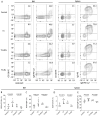Induced Overexpression of B Cell-Activating Factor by Triiodothyronine Results in Abnormal B Cell Differentiation in Mice
- PMID: 37798940
- PMCID: PMC10557412
- DOI: 10.1177/09636897231204075
Induced Overexpression of B Cell-Activating Factor by Triiodothyronine Results in Abnormal B Cell Differentiation in Mice
Abstract
Breakdown of tolerance and abnormal activation in B cells is an important mechanism in the pathogenesis of Graves' disease (GD) and high levels of thyroid hormones (THs) can drive the progression of GD. However, the interactions between THs and abnormal activation of B cells in the context of GD are not well understood. The aim of this study was to investigate B cell-activating factor (BAFF) mediating the cross talk between THs and B cells and the possible underlying mechanisms. A high-level triiodothyronine (T3) mouse model was used to verify T3-mediated induction of overexpression of BAFF and B cell abnormal differentiation. The possible promotion of BAFF overexpression in the mice spleen macrophages during polarization to M1 by T3 was also studied. We showed that high levels of T3 can induce BAFF overexpression and lead to abnormal differentiation of B cells in the mice. While the overexpression of BAFF was observed across many tissue types in the mice, high levels of T3 could induce M1 macrophages polarization by IFN (interferon-gamma)-γ in the spleen of the mice, which in turn generated BAFF overexpression. Our findings provide a novel insight into the interactions between the endocrine and immune systems, as well as provide insight into the role of TH in the pathogenesis of GD.
Keywords: B cell-activating factor (BAFF); B cells; Graves’ disease; macrophages; thyroid hormone.
Conflict of interest statement
Declaration of Conflicting InterestsThe author(s) declared no potential conflicts of interest with respect to the research, authorship, and/or publication of this article.
Figures




Similar articles
-
High levels of thyroid hormones promote recurrence of Graves' disease via overexpression of B-cell-activating factor.J Clin Lab Anal. 2022 Oct;36(10):e24701. doi: 10.1002/jcla.24701. Epub 2022 Sep 13. J Clin Lab Anal. 2022. PMID: 36097969 Free PMC article.
-
High triiodothyronine levels induce myocardial hypertrophy via BAFF overexpression.J Cell Mol Med. 2022 Aug;26(16):4453-4462. doi: 10.1111/jcmm.17470. Epub 2022 Jul 8. J Cell Mol Med. 2022. PMID: 35808902 Free PMC article.
-
Altered expression profile of BAFF receptors on peripheral blood B lymphocytes in Graves' disease.BMC Endocr Disord. 2021 Apr 29;21(1):88. doi: 10.1186/s12902-021-00752-3. BMC Endocr Disord. 2021. PMID: 33926416 Free PMC article.
-
B cell-activating factor and its targeted therapy in autoimmune diseases.Cytokine Growth Factor Rev. 2022 Apr;64:57-70. doi: 10.1016/j.cytogfr.2021.11.004. Epub 2021 Dec 2. Cytokine Growth Factor Rev. 2022. PMID: 34916133 Review.
-
The role of BAFF and APRIL in rheumatoid arthritis.J Cell Physiol. 2019 Aug;234(10):17050-17063. doi: 10.1002/jcp.28445. Epub 2019 Apr 2. J Cell Physiol. 2019. PMID: 30941763 Review.
Cited by
-
Effect of methimazole treatment on Th1, Th17, and Th22 lymphocytes in pediatric Graves' disease patients.Front Immunol. 2024 Oct 3;15:1431686. doi: 10.3389/fimmu.2024.1431686. eCollection 2024. Front Immunol. 2024. PMID: 39439793 Free PMC article.
References
-
- Davies TF, Andersen S, Latif R, Nagayama Y, Barbesino G, Brito M, Eckstein AK, Stagnaro-Green A, Kahaly GJ. Graves’ disease. Nat Rev Dis Primers. 2020;66(1):1–23. - PubMed
-
- Thien M, Phan TG, Gardam S, Amesbury M, Basten A, Mackay F, Brink R. Excess BAFF rescues self-reactive B cells from peripheral deletion and allows them to enter forbidden follicular and marginal zone niches. Immunity. 2004;20(6):785–98. - PubMed
-
- Mackay F, Schneider P. Cracking the BAFF code. Nat Rev Immunol. 2009;9(7):491–502. - PubMed
-
- Mackay F, Silveira PA, Brink R. B cells and the BAFF/APRIL axis: fast-forward on autoimmunity and signaling. Curr Opin Immunol. 2007;19(3):327–36. - PubMed
Publication types
MeSH terms
Substances
LinkOut - more resources
Full Text Sources

